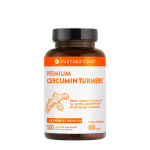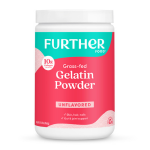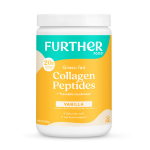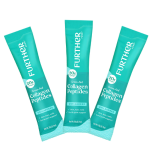If you’re having concerns about the health of your liver, it might be time to kick your nasty sugar habit to the curb. Dr. Mark Hyman explains the dangers of fatty liver, and how sugar, rather than fat, may indeed be the primary culprit. Here’s all you need to know about fatty liver and, to top it off, a customized list of 7 life-changing tips for switching up your diet and lifestyle to heal or prevent this dangerous disease.
“My doctor says I have a fatty liver and I should stay away from fat,” writes this week’s house call.” Is fat really the problem, though? In reality, not so much.
Fatty liver is a dangerous yet misunderstood disease, so your doctor’s concerns are valid. Ninety million Americans (and 17% of children in America) are living with fatty liver. If you’re pigging out on sugar and starch, you’re likely self inflicting fatty liver. Fatty liver literally means your liver fills with fat. This in turn ramps up inflammation, and as a result, vastly increases your risk for developing a multitude of chronic diseases.
However, it’s not fat you need to stay away from-it’s carbohydrates. Interestingly enough, research shows that carbohydrates (and not fat) are to blame for increasing the amount of fat that accumulates in your belly and liver. This may come as a shock to you, but let me explain why this is the case. Sugar is essentially a switch that triggers fat production in your liver (a natural process called lipogenesis). Therefore, our normal response to sugar consumption is liver lipogenesis.
Fructose, the most dangerous sugar that gets directly transported to your liver, actually upregulates lipogenesis. The increased fat production that occurs when we consume copious amounts of sugar explains why these simple carbohydrates, especially fructose, can become the primary cause of liver disease and the leading cause of liver transplants across the nation. Our children’s diets today, chock full of simple sugars like fructose, are sadly setting the stage for liver transplants, high blood pressure, diabetes, heart disease and unhealthy cholesterol levels. To manage these issues, doctors resort to pharmacological measures, which often don’t do the trick. When it comes down to it, it’s not a bright looking future.
How do you know if you have fatty liver? Unfortunately, most people with fatty liver are completely unaware of their condition. Today we’re even seeing 12-year-olds with fatty liver because they guzzled high-fructose soft drinks for years and now need liver transplants. Fructose, the primary sweetener in sodas, is a key player in the ever-increasing rates of nonalcoholic fatty liver disease (NAFLD). So how do you know if you have a fatty liver? Blood tests and an ultrasound can both detect fatty liver. If your blood test comes back abnormal, you must take it seriously. Even if your test comes back normal, don’t think you’re off the hook. A liver function test doesn’t always detect a fatty liver. An ultrasound is more sensitive.
Risks of Fatty Liver You need a healthy liver to combat toxins and chemicals that inevitably become a part of your surroundings. A healthy liver means your body stays healthy, you don’t get sick and you keep up your energy levels. An unhealthy liver, or fatty liver, puts you at risk for increased inflammation, a harmful process which can in turn lead to insulin resistance and a condition known as pre-diabetes, which exponentially increases your chances of developing full blown diabetes if not well controlled. But that’s not all, folks. Excess sugar and starch in the diet can also lead to high triglycerides, low HDL (“good” cholesterol), and high small LDL (“bad” cholesterol). Because of its association with a dangerous triglyceride and cholesterol profile, fatty liver also increases your risk for having a heart attack.
Healthy fats can actually help reverse fatty liver Earlier I mentioned that sugar, not fat, is fully to blame for fatty liver. Perhaps you thought you’d never hear this, but the truth is, in the case of fatty liver, fat may be our friend. Dietary fat actually turns off liver lipogenesis. Seems crazy, right? Let me break it down for you. Unlike carbohydrates and protein, your body prefers to burn rather than store dietary fat, unless you consume it in combination with carbohydrates. With the right, healthy dietary fat (think coconut oil, a medium chain triglyceride), you actually speed up your metabolism! Fat is burned for energy, and you feel more satiated.
To prevent or reverse fatty liver, you’ll want to cut processed carbs and increase healthy fat intake, especially saturated – yes, saturated – fats from healthy foods like coconut and grass-fed beef. The take-home message here is that healthy saturated fats lower inflammation when you eat them as part of a low-carb, high-fiber, omega 3 fatty acid-rich diet. At the same time that you are increasing your healthy fat intake, you need to be drastically reducing the amount of sugar in your diet. Thankfully, newer government guidelines tell us to limit sugar intake, however, I don’t think the current rules and regulations regarding sugar are stringent enough. In my opinion, these guidelines should also include whole grains (complex carbohydrates), which we digest and absorb in the form of sugar (simple carbohydrates). According to current guidelines, you’re still supposed to get one-quarter of your calories from sugar to be healthy. This just doesn’t seem right to me.
Lifestyle and diet strategies to prevent and reverse fatty liver
1. Cutting sugar and flour from the diet, reducing your carb cravings, and adopting a healthy lifestyle to help you banish some of that stubborn belly fat can help you heal and avoid fatty liver.
Here are some additional simple but effective lifestyle and diet strategies to reverse or prevent fatty liver.
2. Get rid of high-fructose corn syrup (HFCS) if it’s part of your diet. Even when it comes in so-called “healthy foods” like salad dressings, steer clear. Consider this: one serving of store bought tomato sauce can have more fructose than a serving of Oreo cookies… YIKES! Pay attention to food labels.
3. Eliminate white, processed flour and banish or greatly reduce dietary starch. Even whole grain flours can increase your blood sugar, put undue stress on your liver and increase your blood triglycerides.
4. Introduce healthy fats into your diet. A great way to combat sugar damage is to eat plenty of healthy fats like olive oil, macadamia nut oil, avocados, coconut oil, grass-fed butter and fish oil. You can get my powerful 21-day plan to easily incorporate healthy fats in Eat Fat, Get Thin.
5. Super foods-- to detox. Regularly eat cruciferous vegetables like broccoli, cauliflower and Brussels sprouts, as well as leafy veggies like kale, collards, cabbage, arugula, and watercress. At least a cup or two every day can help restore liver health. Garlic and onions are amazing sulfur-rich foods that help detox the body. You’ll find amazing recipes and more ways to incorporate these amazing foods in The Blood Sugar Solution 10-Day Detox Diet.
6. Amp up the protein. The key to balancing blood sugar and insulin, reducing cravings and providing your liver the raw materials it needs for adequate detox is to include protein sources at every meal. Start the day with farm fresh eggs or a protein shake. And make sure to Include nuts, seeds, eggs, fish, chicken or grass-fed meat for protein at every meal. A serving size is four to six ounces, or about the size of your palm.
7. Exercise to enhance your metabolism! Routine, daily physical activity improves insulin resistance and reduces fatty liver. Start out with a simple activity like walking for 30 minutes. At higher levels of fitness, try incorporating high-intensity interval training (or burst training) and weightlifting.
Be wise when it comes to supplements. The right supplements can help promote balance while your body is healing. Herbs like milk thistle do wonders for liver health. I also use nutrients like lipoic acid and N-acetyl-cysteine, which are powerful antioxidants that help to heal and rejuvenate your liver while increasing the powerful antioxidant glutathione. Other liver-healing nutrients include B vitamins and magnesium. Incorporate my healthy eating and lifestyle tips into your daily life to help keep your liver healthy. And most importantly, remember it’s the sugar, and not the healthy fats, that you need to stay away from!
Do you or someone you know have a fatty liver? What steps are you taking to prevent or reverse this problem? Comment below or on my Facebook page. Wishing you health and happiness, Mark Hyman, MD
Learn how to incorporate fat into your diet by reading Dr. Hyman’s Eat Fat, Get Thin Cookbook.
Want to read more? What is Dr. Hyman Cooking Today? Discover His Easiest, Healthiest Fall Meal Plan (and Secret Pumpkin Cookie Recipe!)

























